Sushi is the most famous Japanese dish outside of Japan, and one of the most popular among the Japanese themselves, who must prepare it for special occasions and national holidays. Traditionally, sushi is prepared with rice, rolls or balls, it is usually served with fish or other marine products, but sushi can be prepared with fruits and vegetables, without putting fish in.
In most countries, the term sushi commonly given the whole meal, but in Japan that is not so. Japanese call sushi only the rice dish and the pieces of raw fish are called sashimi and although they are similar in pronunciation, has little to do with sushi. The word sushi in Japanese is pronounced with the letter S, while in languages with phonetic alphabets are written with S. However, when used with a prefix denoting a type of sushi, S is replaced by Z, as in the nigiri zushi.
The history of sushi began in ancient times. The roots of sushi lie in Southeast Asia and in the tradition of preservation of fish by fermentation and use of rice. This type of dish is still served in Thailand, Laos and Burma. The first mention of sushi is in a Chinese dictionary from the 2nd century. For millennia, Japanese cuisine is mainly rich in seafood, fish and seaweed.

During the Edo period, "sushi" is true for fish marinated in vinegar. The need for proper and permanent storage of marine products was urgent and the Japanese began to keep fish clean and fresh caught in a unique way. They arranged it in large wooden dishes. Each line of fish is sprinkled with salt and sometimes with rice that prevent fish from rotting.
They covered the fish with a heavy lid and it is preserved for several months, and over the centuries, the process of treatment shortened. Finally, in the 19th century did chef Yohei begin to first offer raw fish. The fish is flavored with rice, rice vinegar, which achieved a better taste and a shortened time to prepare sushi. This dish is closer to the now familiar patterns. In the following years, the technology evolved and changed significantly, up to the level of today's concept of sushi.

Preparation of Sushi
Nowadays sushi can be defined as a dish containing rice prepared with vinegar. Today, sushi has very little in common with its ancestor. Its main ingredients are still fish and rice, but the method of preparation and consumption is quite different. Rice vinegar is added directly into the rice, they use fresh fish and fermentation is absent.
Sushi is eaten either with your fingers or chopsticks, there are special tools that are intrinsically linked to the preparation of sushi. The makisu mat is made from bamboo and cottons threads used to prepare different types of food. The size is 25 x 25 cm, but can vary. This kind of thin mat is used to make maki sushi.
After use, the makisu should be well drained to prevent bacteria. It is often covered with a thin transparent wrap before use, to avoid difficult cleaning afterwards. This is especially necessary in the preparation of uramaki.
Sushi rice is white, grained rice mixed with a dressing of rice vinegar, sugar, salt, kombu (edible dried kelp) and eventually sake. The rice should be cooled to room temperature before use. Some use grained brown rice and wild rice too. Sushi rice has a certain stickiness. If the rice is too sticky, you will have a very soft texture, if it is not sticky enough to look dry.
Nori leaves are dried edible seaweed grown traditionally in the ports of Japan. Nori leaves are factory manufactured and are sold in standard form and size 18 x 21 cm. Guality nori leaves are thicker, but they are also smooth, shiny, black and have no holes. Japanese kids eat nori as a snack.
Wasabi (Wasabia japonica) is another optional addition to sushi. Often called Japanese horseradish. it is used as a spice and has an extremely strong flavor. The spicy wasabi paste is made from the roots of the plant. True wasabi has anti-bacterial properties and can reduce the risk of food poisoning. It is not the quantity of wasabi consumed, but the amount of fumes that determine to what extent you will experience discomfort. Expect a sinus pain, which begins suddenly and quickly and also quickly fades.

Storage of sushi
To prepare sushi, the fish must be stored according to the established norms. All fish must be frozen for at least 24 hours at a temperature not higher than -20 ° C. According to the requirements of the Russian health authorities, fish for sushi should stand frozen to -18 ° C for 36 hours.
Types of sushi
The main ingredient in all kinds of sushi is sushi rice. Different recipes for sushi vary the filling and sprinkling, spices and method of preparation. The same ingredients can be combined in a traditional or a contemporary way, which can lead to very different results.
Among the popular types of sushi are:
Inari - Inari-zushi is a simple and inexpensive type of sushi. It is a fried pouch of tofu (aburage), stuffed with rice.
Nigiri - small rice "fingers", covered with fish or something else. There are countless combinations of nigigi-zushi. Some of them are tuna, shrimp, eel, squid, octopus and omelets.
Gunkan - small cups made from sumeshi and nori filled with various seafood. Among the numerous combinations of gunkan-zushi most famous are those with sea urchin and various kinds of fish eggs.
Maki-zushi - rolls of rice wrapped in dried pressed seaweed (nori leaves) with fish and / or vegetables. There are different types of maki-zushi you can prepare:
Futo-maki - thick rolls
Hoso-maki - thin rolls
Ura-maki – inside out roll
Temaki - rice cones, fish and vegetables wrapped in seaweed/(nori).
Oshi-zushi - pressed sushi, in which the fish is pressed on rice in a wooden box
Chirashi - a dish in which seafood, mushroom and vegetables are spread out over sumeshi
Sashimi - raw fish served in pieces. It is often cut in different ways to emphasize the appearance of the fish. Hira zukuri is the standard square piece, thinner ones are called Ito zukuri, but Kaku zukuri is almost as thin paper.
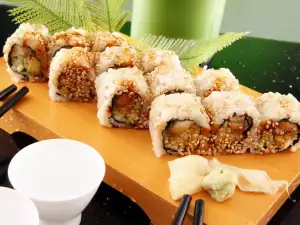
Serving sushi
Tradition requires sushi to be served in Japanese minimalist style - tables with geometric shapes, on or two-colors, leather or lacquered wood, in accordance with the aesthetic qualities of the kitchen. Sushi is served with soya sauce, wasabi (horseradish) paste and pickled Ggri (Japanese ginger).
Soya sauce should be served in a separate small bowl. Traditional sushi etiquette requires you to rotate it with the filling towards the sauce, as the rice is mealy and dipping sushi can make it fall apart in a bowl with rice grains remaining in the sauce. This turn of sushi with chopsticks is not an easy task and soy sauce can be greased on the sushi and ginger is used as a brush. Mixing wasabi paste with soy sauce is in fact for eating sashimi and is considered unacceptable for the consumption of sushi.
Many restaurants offer specific sushi meals at a fixed price. They are often called sho-chiku-bai and include three levels - sho / matsu (pine), chiku / take (bamboo) and bai / ume (Japanese apricot fruit), matsu which is the most expensive and ume, which is cheapest.
Now worldwide sushi is served on the kaiten (also known as sushi train). On a conveyor belt, there are moving containers of different colors, each of which contains a different combination of sushi. When dishes with sushi pass by customers, they choose what to take. The account is calculated by the number of plates of each color, the menu must specify which color plate is at what cost.
Nigiri-zushi is traditionally eaten with fingers as sushi rice sushi is mealy and disintegrates the moment you eat it. Eating nigiri zushi with your fingers is permitted even during dinner, but today, this is rarely practiced. So today, most Japanese eat sushi with chopsticks.
Benefits of Sushi
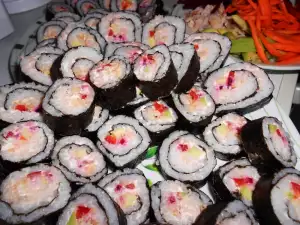
Sushi improves your stomach, heart and blood vessels, stimulates brain activity. The wasabi in sushi has antiseptic properties. Rice, in turn, improves digestion, thanks to the cellulose contained in it. Regular consumption of sushi helps to reduce your weight and prevent depression. All the benefits of rice and fish can be attributed to small charming sushi bites. Of course, sushi should not be consumed with low-quality soy sauce, which belongs to the healthiest foods.
Dangers of sushi
Sushi is not completely harmless to human health, which is often due to improper preparation. Some large fish, such as tuna, contain high amounts of mercury as tuna is on top of the food chain among marine creatures. Thus, consumption of large amounts of tuna can cause mercury poisoning. In the United States, it is recommended not to consume more than 170 to 340 g large fish and shellfish a week.
Rarely, parasitic infections from raw fish still appear - less than 40 cases per year in the U.S. There are three main types of parasites - Clonorchis sinensis (flukes/liver leeches), Anisakis (nematode/roundworm) and Diphyllobothrium (frequency/tape worms). The danger of infection anisakis is greatest in the consumption of freshwater fish such as salmon (salmonids), as well as trout.
If pre- cooked fish is used for the sushi, the risk of infection can be minimized. Moreover, it can be baked, marinated with salt and vinegar or deep frozen for one day. Nematodes are worms that can even cause death.
They also cause acute ulcers and can lead to necrosis and perforation of the stomach wall and colon. The incubation period is from a few hours to 7 days. You will experience nausea, vomiting, stomach pain, fever, rash, diarrhea.
Some types of sushi are prepared with Fugu fish, blowfish, or shellfish. They can cause severe poisoning if not prepared properly. The insides of the blowfish contain lethal amounts of the poison tetrodotoxin. So Japan only chefs who have passed a special examination before the Prefecture are permitted to prepare it.
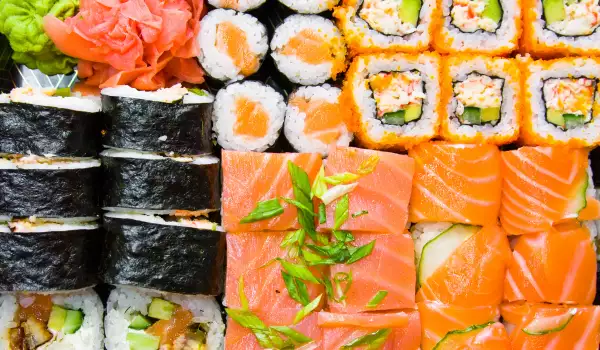

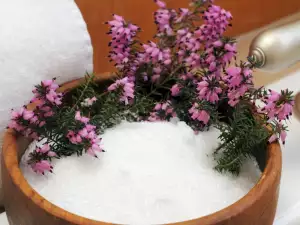
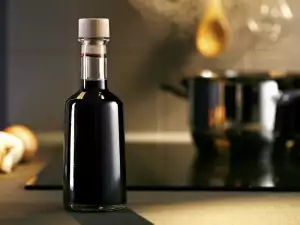



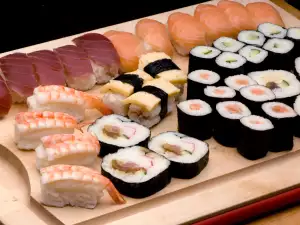



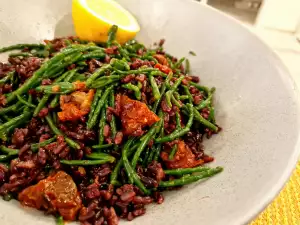

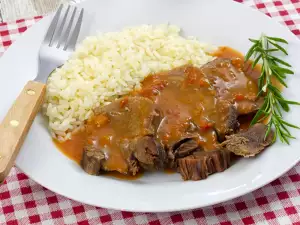




Comments